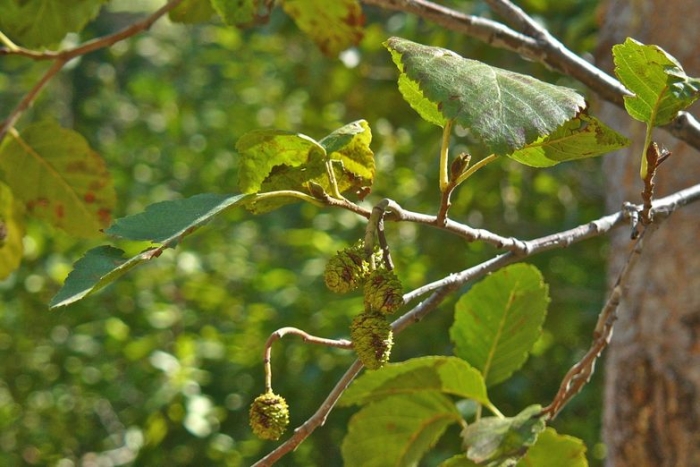Thinleaf Alder
(Alnus incana subsp. tenuifolia)
Thinleaf Alder (Alnus incana subsp. tenuifolia)
/
/

Jean Pawek
CC BY 3.0
Image By:
Jean Pawek
Recorded By:
Copyright:
CC BY 3.0
Copyright Notice:
Photo by: Jean Pawek | License Type: CC BY 3.0 | License URL: http://creativecommons.org/licenses/by/3.0/ | Attribution: 2013 Jean Pawek | Publisher: Calphotos |

















































Estimated Native Range
Summary
Alnus incana subsp. tenuifolia, commonly known as Thinleaf Alder, is a deciduous shrub or small tree native to riparian zones, wetlands, and moist open woodlands across the Western USA, Western Canada, and Yukon. It typically grows to a height of 3-9 feet (0.9-2.7 meters) and a width of 3-7 feet (0.9-2.1 meters), featuring a multi-stemmed, clumping form. The Thinleaf Alder has serrated, lance-shaped leaves and catkins that appear before the leaves in early spring. The flowers are not particularly showy, but the male catkins are noticeable. This species also produces small, woody cones that persist into winter, adding to its visual interest.
The Thinleaf Alder is valued for its ability to thrive in wet conditions and for its use in stabilizing streambanks and preventing erosion. It is often used in naturalized plantings, reclamation projects, and as a component of riparian buffer zones. This alder is also beneficial for wildlife, providing habitat and food for birds and insects. It prefers full sun but can tolerate partial shade, and it requires moist to wet soil conditions with good drainage. While it is adaptable to a range of soil types, it does best in soils that are slightly acidic to neutral. One potential problem with this plant is that it can be susceptible to leaf spot diseases, but these are generally not serious.CC BY-SA 4.0
The Thinleaf Alder is valued for its ability to thrive in wet conditions and for its use in stabilizing streambanks and preventing erosion. It is often used in naturalized plantings, reclamation projects, and as a component of riparian buffer zones. This alder is also beneficial for wildlife, providing habitat and food for birds and insects. It prefers full sun but can tolerate partial shade, and it requires moist to wet soil conditions with good drainage. While it is adaptable to a range of soil types, it does best in soils that are slightly acidic to neutral. One potential problem with this plant is that it can be susceptible to leaf spot diseases, but these are generally not serious.CC BY-SA 4.0
Plant Description
- Plant Type: Shrub, Tree
- Height: 3-9 feet
- Width: 3-6.5 feet
- Growth Rate: Rapid
- Flower Color: N/A
- Flowering Season: Spring
- Leaf Retention: Deciduous
Growth Requirements
- Sun: Full Sun
- Water: High
- Drainage: Medium, Fast
Common Uses
Bee Garden, Bird Garden, Butterfly Garden, Erosion Control, Low Maintenance, Rabbit Resistant, Water Garden
Natural Habitat
Native to riparian zones, wetlands, and moist open woodlands
Other Names
Common Names: Mountain Alder, Speckled Alder
Scientific Names: , Alnus incana subsp. tenuifolia, Alnus tenuifolia, Alnus incana var. occidentalis, Alnus occidentalis, Alnus incana var. virescens, Alnus tenuifolia var. virescens, Alnus tenuifolia var. occidentalis, Alnus densiflora, Alnus glutinosa var. virescens
GBIF Accepted Name: Alnus incana subsp. tenuifolia (Nutt.) Breitung